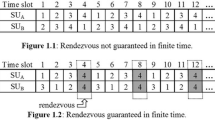Abstract
Rendezvous is a fundamental challenge in cognitive radio networks where users can find each other on a specific channel and hence establish a communication link. Most previous works are based on the strong assumption that users are able to find a set of available channels after the spectrum sensing stage and the status of these channels are stable all the time, which, however, may be unrealistic in some scenarios. As a solution, we design a fair channel hopping protocol with dynamic channel state, by adopting the concepts of Markov process, Jenkins Hash and Josephus recursive. Two protocols (FCH_S, FCH_A) are proposed for synchronous clock and asynchronous clock network model, respectively. The channel activity model is built with the aid of Markov process. By taking advantage of Jenkins Hash and Josephus recursive, the fairness of protocol is guaranteed. We assume that (1) a secondary user, SU\(_A\), rendezvous with SU\(_B\); (2) corresponding channels available probability are \(p_a\) and \(p_b\). According to these assumptions, we can prove that expect rendezvous time for FCH_S and FCH_A are \(\dfrac{1}{p_{a}p_{b}}\) and \(\dfrac{1}{p_{a}}+\dfrac{1}{p_{b}}-1\). Simulation results demonstrate that FCH_S and FCH_A can achieve better performance in contrast to the exiting channel hopping protocols (e.g. H.Tan and HHCH).





Similar content being viewed by others
References
Yucek, T., & Arslan, H. (2009). A survey of spectrum sensing algorithms for cognitive radio applications. IEEE Communications Surveys & Tutorials, 11(1), 116–130.
Ghasemi, A., & Sousa, E. S. (2008). Spectrum sensing in cognitive radio networks: Requirements, challenges and design trade-offs. IEEE Communications Magazine, 46(4), 32–39.
Khan, A. A., Rehmani, M. H., & Reisslein, M. (2015). Cognitive radio for smart grids: Survey of architectures, spectrum sensing mechanisms, and networking protocols. IEEE Communications Surveys & Tutorials, 18(1), 860–898.
Akhtar, F., Rehmani, M. H., & Reisslein, M. (2016). White space: Definitional perspectives and their role in exploiting spectrum opportunities. Telecommunications Policy, 40(4), 319–331.
Theis, N. C., Thomas, R. W., & DaSilva, L. A. (2011). Rendezvous for cognitive radios. IEEE Transactions on Mobile Computing, 10(2), 216–227.
Xiaogang, Q., Rong, G., Lifang, L., & Wei, Y. (2017). ADFC-CH: Adjusted disjoint finite cover rendezvous algorithms for cognitive radio networks. Wireless Networks, 2017(4), 1–10.
Jia, J., Zhang, Q., & Shen, X. (2008). HC-MAC: A hardware-constrained cognitive mac for efficient spectrum management. IEEE Journal on Selected Areas in Communications, 26(1), 106–117.
Zou, Y., & Yoo, S. J. (2015). A cooperative attack detection scheme for common control channel security in cognitive radio networks. In IEEE International Conference on Ubiquitious and Futures Networks (pp. 606–611).
Yoo, S. J., Nan, H., & Hyon, T. I. (2009). DCR-MAC: Distributed cognitive radio mac protocol for wireless ad hoc networks. Wireless Communications & Mobile Computing, 9(5), 631–653.
Li, J., Zhao, H., Wang, H., Zhou, L., & Wei, J. (2016). Demo: Multi-channel access and rendezvous in CRNS. In ACM MOBIHOC.
Maryam, R. (2015). Frequency hopping in cognitive radio networks: A survey. In IEEE international conference on wireless for space and extreme environments (pp. 1–6).
Haosen, P., Zhaoquan, G., Xiao, L., & Qiang Sheng, H. (2016). Dynamic rendezvous algorithms for cognitive radio networks. In IEEE International Conference on Communications (pp. 1–6).
Rahman, M. J. A., Rahbari, H., & Krunz, M. (2012). Adaptive frequency hopping algorithms for multicast rendezvous in DSA networks. In IEEE International Symposium on Dynamic Spectrum Access (pp. 517–528).
Tan, H., Yu, J., Liang, H., Wang, R., & Han, Z. (2015). Optimal rendezvous strategies for different environments in cognitive radio networks. In ACM International Conference on Modeling, Analysis and Simulation of Wireless and Mobile Systems (pp. 65–72).
Chao, C. M., Fu, H. Y., & Zhang, L. R. (2015). A fast rendezvous-guarantee channel hopping protocol for cognitive radio networks. IEEE Transactions on Vehicular Technology, 64(12), 1–1.
Paul, R., & Choi, Y.-J. (2016). Adaptive rendezvous for heterogeneous channel environments in cognitive radio networks. IEEE Transactions on Wireless Communications, 15(11), 7753–7765.
Jia, J., & Zhang, Q. (2013). Rendezvous protocols based on message passing in cognitive radio networks. IEEE Transactions on Wireless Communications, 12(11), 5594–5606.
Pal, S. K., Bhardwaj, D., Kumar, R., & Bhatia, V. (2009). A new cryptographic hash function based on latin squares and non-linear transformations. In Advance Computing Conference, 2009. IACC 2009. IEEE International (pp. 862–867). IEEE.
Menezes, A. J., Van Oorschot, P. C., & Vanstone, S. A. (1996). Handbook of applied cryptography. Boca Raton: CRC Press.
Dowdy, J., & Mays, M. E. (1989). Josephus permutations. Journal of Combinatorial Mathematics and Combinatorial Computing, 6, 125–130.
Cormen, T. H. (2009). Introduction to algorithms. Cambridge: MIT Press.
Saleem, Y., & Rehmani, M. H. (2014). Primary radio user activity models for cognitive radio networks: A survey. Journal of Network and Computer Applications, 43, 1–16.
Canberk, B., Akyildiz, I. F., & Oktug, S. (2011). Primary user activity modeling using first-difference filter clustering and correlation in cognitive radio networks. IEEE/ACM Transactions on Networking (TON), 19(1), 170–183.
Acknowledgements
Project supported by the National Natural Science Foundation of China (Grants Nos. 61572435, 61472305, 61473222), the Natural Science Foundation of Shaanxi Province (Grants Nos. 2015JZ002, 2015JM6311), Ningbo Natural Science Foundation (Grant Nos. 2016A610035, 2017A610119), Complex Electronic System Simulation Laboratory (DXZT-JC-ZZ-2015-015).
Author information
Authors and Affiliations
Corresponding author
Rights and permissions
About this article
Cite this article
Qi, X., Gao, R., Liu, L. et al. An improved fair channel hopping protocol for dynamic environments in cognitive radio networks. Wireless Netw 25, 903–911 (2019). https://doi.org/10.1007/s11276-017-1601-3
Published:
Issue Date:
DOI: https://doi.org/10.1007/s11276-017-1601-3




